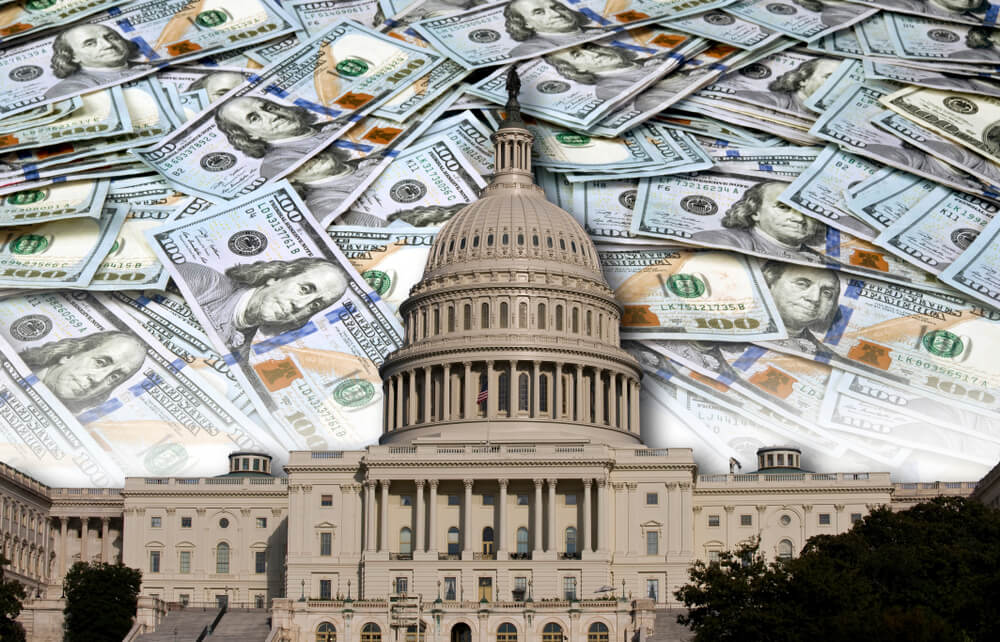United States Secretary of Treasury Janet Yellen has an incredible job. She writes rubber checks to pay America’s bills. Yet, somehow, the rubber checks don’t bounce. Instead, like magic, they clear.
How this all works, considering the nation’s technically insolvent, is quite miraculous. But it works, nonetheless. Again and again, the Treasury borrows money. And Washington spends it.
Yellen likely knows that full faith and credit is too good to be true. The U.S. government’s gross fiscal mismanagement should call the veracity of its notes into question. But why focus on it when there’s an abundance to be acquired from weekly Treasury bill auctions?
On a recent trip to China, Yellen was spotted by a local food blogger consuming a plate of potentially magic mushrooms. An aide to Yellen later confirmed that she did, indeed, order them. The restaurant’s “staff said she loved [the] mushrooms very much. It was an extremely magical day.”
We don’t know what their acute effects on Yellen were, while she was in Beijing. But the mushrooms appear to be contributing to her chronic hallucinations about the U.S. economy’s current health. This week, for example, while attending the G20 meeting in India, Yellen remarked:
For the United States, growth has slowed, but our labor market continues to be quite strong. I don’t expect a recession. The most recent inflation data were quite encouraging.
These, no doubt, are the fantasies of a person under the influence of mind-altering chemicals. Either that, or her mind has turned soft over decades of working as a professional economist for the Federal Reserve and the Treasury.
Tempered Perspective
The unemployment rate reported by the Bureau of Labor Statistics (BLS) is, in fact, just 3.6%. Yellen can celebrate the data point. But the quality of the jobs being created is not the type that will drive economic growth.
Higher-paying technology and finance jobs are being purged. While leisure, hospitality and government are the sectors contributing to employment growth. These jobs may be important. Still, they will not create new wealth or help America compete with its global rivals.
Yellen also remarked that she doesn’t expect a recession. Maybe this is why you should expect one.
Her predictive acumen has missed the target in the past. If you recall, in 2017 she said she did not believe another financial crisis would happen in our lifetime. Since then, we’ve had one financial crisis after another, including the most recent bank failures this spring.
Just this week, Bank of America reported its bond losses in the second quarter increased $7 billion to nearly $106 billion. And Starwood Capital Group just defaulted on a $215.5 million mortgage on an Atlanta office tower. Probably nothing to worry about, right?
In addition, this week Taiwan Semiconductor Manufacturing Company (TSMC), the mega chip maker, reported its first profit drop in 4 years. Revenue slipped 10% from a year ago. What’s more, net income fell 23.3%. Wasn’t AI supposed to drive silicon wafer production to commanding heights?
With respect to what Yellen called ‘encouraging inflation data’. While under the influence, she was likely referring to the recent CPI report from the BLS, which showed that in June, consumer prices increased at an annualized rate of 3%. This is still 50% higher than the Fed’s arbitrary inflation target.
Moreover, the energy commodities component showed a 16.7% price decline over the last year. This has coincided with President Biden draining the Strategic Petroleum Reserve to a 40-year low. Without these short-sighted actions, the current inflation data would be much less encouraging.
Structural Crisis
In short, the U.S. economy’s prospects do not quite align with Yellen’s positive outlook. And if you look out further than just the current data reports, you’ll be greeted with a structural crisis of significant consequence.
In fact, simple arithmetic quickly reveals the precarious predicament the 118th Congress is putting the American people in.
The Treasury Department, the agency Yellen oversees, recently reported that for the first 9 months of the 2023 fiscal year, the federal government ran a budget deficit of nearly $1.4 trillion. That’s a 170% increase from the same period last year.
The big surprise, however, was that interest on Treasury debt securities for the first 9 months of FY2023 topped $652 billion. A 25% increase for this period a year ago.
Rapid and repeated interest rate hikes by the Fed to contain the raging price inflation of its own making, has blown out the interest owed on Treasury debt. Anyone with half an inkling knew this was coming from miles away.
The growth of federal debt has been out of control for decades. But the rate of debt growth in the 21st century has rapidly accelerated.
The solution that’s commonly offered by the politicians for getting a handle on Washington’s debt problem is for the economy to somehow grow its way out. Countless policies over the years have generally involved borrowing money from the future and spending it today.
Yet economic growth never manages to outpace the debt increases. Instead, the debt piles up higher and higher with each passing year. The simple fact is you can’t grow your way out of debt when the debt’s increasing faster than gross domestic product (GDP).
For example, in 2000 the federal debt was about $5.6 trillion, and U.S. GDP was about $10 trillion. Today, the federal debt is over $32.5 trillion, and GDP is about $26.5 trillion. In just 23 years the federal debt has increased by over 480% while GDP has increased just 165%.
How Washington Ruined America’s Future
Recently, the Peter G. Peterson Foundation attempted to characterize the $32 trillion federal debt. The number is so large it is difficult to comprehend. Here is some of what the foundation came up with:
The $32 trillion debt is more than the combined values of the economies of China, Japan, Germany and the United Kingdom. It represents $244,000 per household or $96,000 per person in America. And if every household contributed $1,000 per month towards paying down the national debt it would take over 20 years.
Without question, Washington has run up an impossible tab. Yet, what does it have to show for all this recklessness?
America’s cities are decaying from the inside out. The infrastructure is crumbling. The country has been involved in one overseas quagmire after another.
The political will to stop this massive debt pileup has been nonexistent. Democrats and Republicans have both spent like drunken sailors. There’s been no tradeoffs or compromises to cut spending. There’s been zero effort to balance the budget. And now it’s too late.
As mentioned above, interest on Treasury debt securities for the first 9 months of FY2023 topped $652 billion — a 25% increase from a year ago. But this is just the beginning.
As interest rates continue to rise, the annual interest on Treasury debt will soon pass $1 trillion. That would put this line item at par with outlays for Social Security, the U.S. government’s largest expenditure.
This would also put spending on interest payments above the combined spending of research and development, infrastructure, and education.
Consequently, by repeatedly borrowing and spending money, piling up massive debt, and then being forced to jack up interest rates, Washington has ruined America’s future.
Yippee! Look Ma, no hands!
[Editor’s note: Is the Pentagon secretly provoking China to attack Taiwan? Are your finances prepared for such madness? Answers to these important questions can be found in a unique Special Report. You can access a copy here for less than a penny.]




